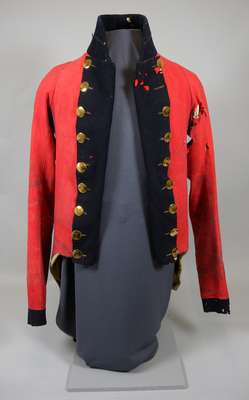British Uniform Coatee Worn by Colonel Daniel McDougal- 1812
Description
- Sponsors

 This item is a part of the 1812 History digitization project. This project was made possible with the support of the Department of Canadian Heritage through the Canadian Culture Online Strategy.
This item is a part of the 1812 History digitization project. This project was made possible with the support of the Department of Canadian Heritage through the Canadian Culture Online Strategy.- Media Type
- Object
- Description
- This uniform coatee was worn by Colonel Daniel McDougal when he was an Ensign at the Battle of Lundy’s Lane on July 25, 1814. The design is for a Junior officer (ensign or lieutenant) of the Volunteer Incorporated Militia Battalion. It is double breasted with an open stand up collar with a thin black lace trim. The cuffs and collar are dark blue with a short turned up tail. It is lined with white linen and the inside lapels are black. The buttons are reproduction brass.
McDougal was born in Inverness, Scotland, in 1782 and came to Canada with his parents who settled in Glengarry County. When the war broke out in June 1812, he was in the Glengarry Militia and took part in the capture of Ogdensburg on 22 February 1813. On 20 March he obtained an ensign's commission in the Battalion of Upper Canada Incorporated Militia. He was promoted to the rank of Lieutenant on 30 March and is said to have been at Fort George on 27 May when it was taken by the Americans and later at Twelve Mile Creek. He was severely wounded at Lundy's Lane and lying in the field after having been struck seven times, he was initially reported to be "mortally wounded". Although he recovered, McDougal had subsequent health problems as well as a lead ball in his body for the rest of his days. He nevertheless lived a long and active life. McDougal's coatee respects Governor Simcoe's 1794 instructions, that is scarlet with blue "facings" (i.e. the collar, cuffs and lapels) trimmed with "plain gilt metal buttons". To denote his lieutenant's rank, Daniel McDougal wore a gold epaulet with thin gold fringes on the right shoulder only. On 1 June 1814, a gold lace edging was ordered added to cuffs and collars on the officers' coatees of the Upper Canada Militia. Thus Lieutenant McDougal's coat was most likely made locally between the date of his first commission, in March 1813 and before the summer of 1814. Being in the field at the time, adding gold edging lace at the collar and cuffs was not an urgent matter for many officers and Lieutenant McDougal's coatee remained plain. The cuffs, quite small and without buttons, are the only exception to this otherwise regulation coatee.
When the coatee, now in possession of the museum, was donated a century ago, it was said to be the one that Lieutenant McDougal wore when he was wounded during the Battle of Lundy's Lane. McDougal was in no shape to resume his duties for many months. He was granted a small pension on account of his many wounds. So the coatee, apart from its cuffs, remained much the same as when he wore it in the field. Garments with such a history are rare, even more so if made in Canada and are fitting reminders of the sacrifices made by our forebears to keep our country free. - Date of Original
- 1812
- Dimensions
-
Width: 33
Length: 80
- Subject(s)
- Local identifier
- 972.902
- Geographic Coverage
-
-
Ontario, Canada
Latitude: 43.25012 Longitude: -79.06627
-
- Recommended Citation
- Image courtesy of the Niagara Historical Society & Museum
- Terms of Use
- Please contact the Niagara Historical Society & Museum for any reproductions of this image.
- Contact
- Niagara Historical Society MuseumEmail:contact@niagarahistorical.museum
Website:
Agency street/mail address:43 Castlereagh Street
P.O. Box 208
Niagara-on-the-Lake, ON
L0S 1J0


